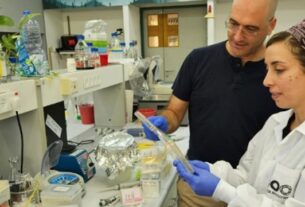What really happens in the body when you are stressed
Researchers focused on how chronic stress affects the brain. Now it is known how it affected the body at the molecular level

When we are stressed – the whole body is stressed. Some will feel the tension in the lower abdomen, while others will experience stiffness in the neck or jaw area, but only one organ in the body will grow, and even double in volume, as a result of constant exposure to pressure – the adrenal gland that secretes the stress hormone cortisol.
It has been known for more than a century that these glands are the last station of the “pressure axis” that began with “stressful” messages sent from the brain to the bloodstream.
Scientists at the Weizmann Institute of Science and their research partners recently revealed, in unprecedented detail, the extent of the changes taking place in this area – and in the other tissues of the pressure axis – and even identified a new subpopulation of cells involved in response to chronic stress.
The findings of the study, published today in the scientific journal Science Advances, may pave the way for new treatments for chronic stress disorders such as anxiety, depression, obesity, and diabetes.
The new study, led by postdoctoral fellow Dr. Juan Pablo Lopez in the joint neurobiology lab of Prof. Alon Chen and the Max Planck Institute of Psychiatry, made use of a relatively new technique that allows researchers to identify differences across all cell types in a tissue. This method is something like identifying the individual fruits in a bowl of fruit salad.
As we add ingredients to a fruit smoothie, we may get more surprising flavors, but we will have a hard time putting our finger on the contribution of each ingredient to the end result.
A fruit salad, on the other hand, allows you to combine flavors and textures without compromising the unique contribution of each and every fruit.
– rather than the standard methods of turning that fruit salad into a “smoothie” and then trying to identify the average characteristics of all the fruits together.
But in this case, the task was much more complex than separating the apples from oranges.
Technological developments of recent years allow scientists to measure the expression of genes in tissue at the level of the individual cell, thus characterizing in an unprecedented resolution differences between cells in the same tissue.
In the laboratory, the team undertook to prepare a particularly complex fruit salad: the postdoctoral researcher, Dr. Juan Pablo-Lopez, mapped the “pressure axis” along with its entire cell level. The lone – both in normal mice and in mice exposed to chronic stress.
In total, Dr. Pablo-Lopez mapped 21,723 cells along the pressure axis – from the parenteral nucleus (PVN) in the hypothalamus, through the pituitary gland to the adrenal gland.
When the researchers compared the pressure map in normal and “stressed” mice, they found molecular changes Many in the tissues examined: 66 genes that responded differently in the hypothalamus, 692 in the pituitary gland – and 922 in the adrenal gland, where the most significant changes were also observed in the composition of the cell populations in the tissue.
Thanks to the pressure axis mapping, the scientists first identified a subpopulation of endocrine cells in a particular area of the adrenal cortex.
In a state of chronic stress, these cells were over-represented and even larger – the two reasons for the known swelling of the adrenal gland.
The researchers also identified an overexpression of the Abcb1 gene in these cells – a gene that encodes an important protein in the cell membrane that serves as a pump to remove substances from the cell.
The overexpression of the gene is probably intended to address situations of chronic stress. “Excess production of the stress hormone requires a mechanism for its rapid release,” explains Dr. Pablo-Lopez.
To test whether the findings in mice were also valid in humans, the researchers, in collaboration with university hospitals in the UK, Germany, Switzerland, and the United States, examined adrenal gland tissue removed from people with Cushing’s disease – a unique clinical condition in which the pressure axis is in operation. Persistent as a result of a tumor in the pituitary gland. These patients suffer from many symptoms associated with chronic stress – obesity, diabetes, hypertension, and a tendency to depression and nervousness – and are sometimes forced to excise their adrenal glands. Examination of the tissues removed from these patients matched the image obtained in the mice.
In addition, the findings were also reinforced in patients with depression.
Previous studies have shown that the Abcb1 gene may carry different manifestations in humans – a phenomenon known as polymorphism; These different forms may affect human susceptibility to various diseases or treatments.
One form of the gene has been linked to depression in the past. Analysis of blood samples from depressed patients with this version of the gene – before and after artificial activation of the pressure axis – shocked the findings in mice and showed that the change in the gene affects the ability of their adrenal glands to cope with pressure signals.
Chronic stress can affect the body in different and varied ways such as mental disorders, obesity and damage to the immune system – These changes and their intensity of course also depend on the history and personal genetics of each of us.
Mapping the pressure axis at the individual cell level illustrates the extent of changes that may occur in these tissues as a result of pressure exposure. “Much of the research in the field so far has focused on how chronic stress affects the brain – we knew much less about how the peripheral components of the axis are affected at the molecular level,” says Prof. Alon Chen. “The new findings mark new possible targets for the treatment of diseases resulting from chronic stress – and open up new directions for further research.”
Read more about: Stress, Weizmann Institute of Science



